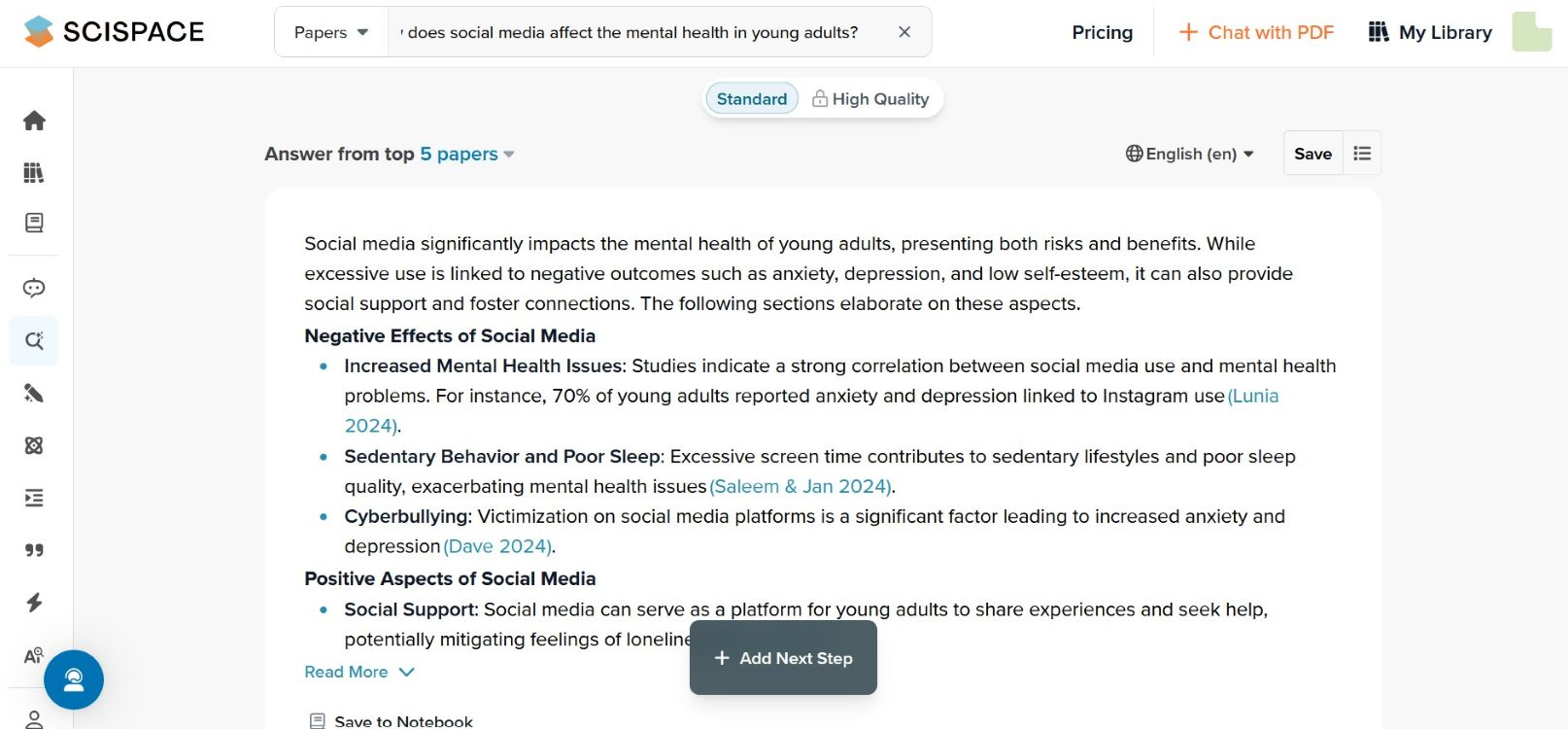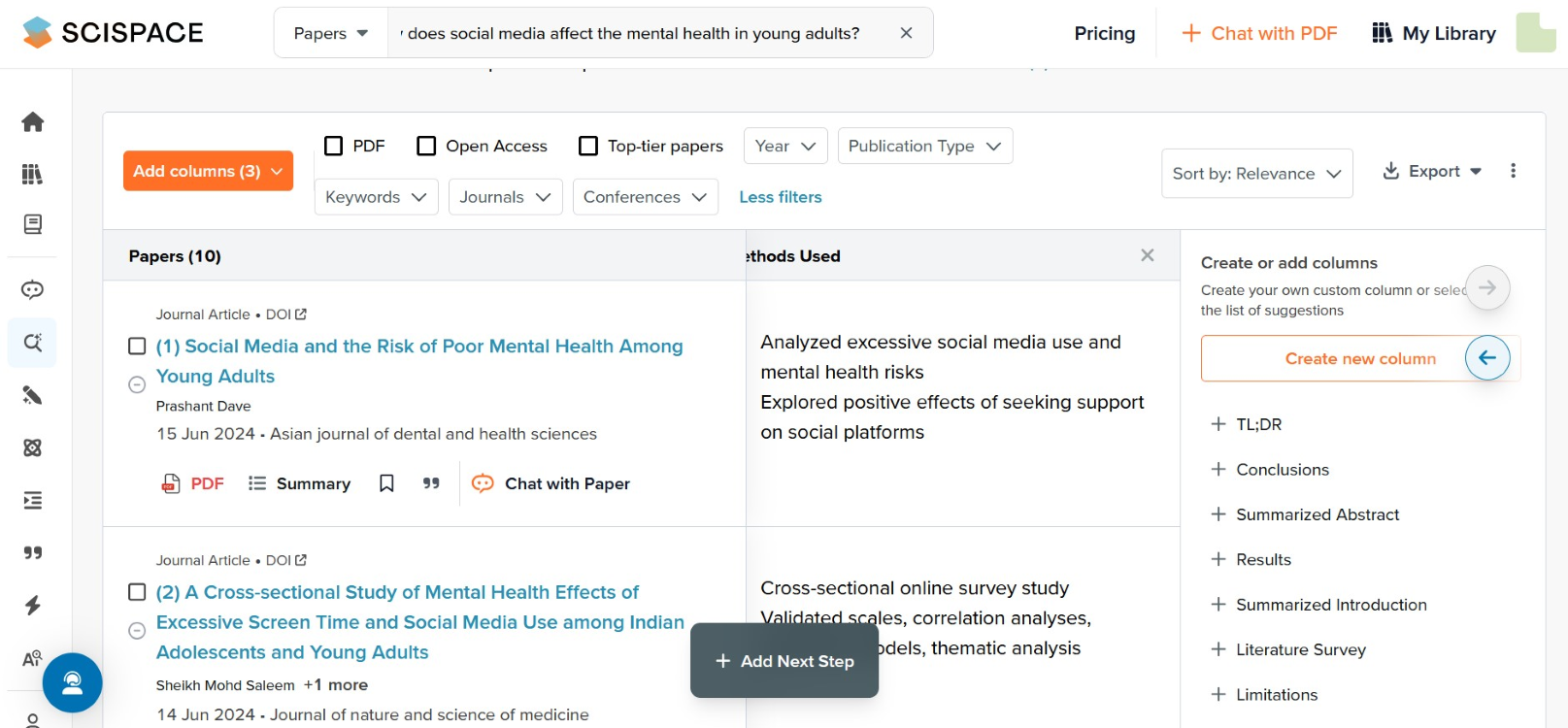An AI Assistant to Streamline the Research Process
With a couple of standout features in a cluttered interface, this AI research assistant may be a helpful adjunct to traditional research methods for some users

With a couple of standout features in a cluttered interface, this AI research assistant may be a helpful adjunct to traditional research methods for some users
SciSpace is an AI-powered research assistant tool designed to streamline the academic research process. The platform’s standout feature is its AI-powered literature review search, which combines semantic and lexical search to retrieve relevant resources based on natural language queries. Results are presented in a matrix with generated summaries of top papers, similar to that of its competitor Elicit. Another notable feature, Chat with PDF, allows users to ask specific questions about and obtain summaries of sections of a paper.
While SciSpace offers a comprehensive suite of tools, the abundance of options can lead to an overwhelming user experience. Like other AI-powered tools in the market, it has limitations, including occasional inaccuracies in AI-generated content. Despite these challenges, SciSpace introduces useful advancements in AI-assisted academic research, offering potential time savings for researchers navigating vast amounts of scholarly literature.
SciSpace’s web-based platform offers nine primary features to support researchers at various stages of their work:
The Literature Review, undoubtedly the platform’s star feature, utilizes a Large Language Model (LLM) to conduct semantic search to identify relevant papers and then summarize the top five.
The search results are presented in a matrix, where specific details about each paper—such as findings, results, and methods—are extracted and organized. According to Saikiran Chandha, CEO of SciSpace, the platform draws from sources like OpenAlex and Semantic Scholar, in addition to web crawlers that index repositories like ArXiv and BioRxiv, covering around 200 million documents represented as embeddings—compact numerical representations that capture each paper’s meaning and relationships (SMU Researcher Club, 2024)—which allows the platform to quickly search through large amounts of text.

The Chat with PDF function allows users to interactively query PDF documents, facilitating deeper engagement with research materials. In some blog posts by SciSpace, this feature is also called SciSpace Copilot, though it is not actually related to the Microsoft Copilot (Sucheth, 2023).

The AI Writer generates sections of academic papers, including introductions, conclusions, and opposing arguments, including citations. Drafts created with this feature are stored under “My Library.”
The Extract Data feature pulls relevant information from user-uploaded PDF documents, in the same manner as the Literature Review. The resulting tables are also saved under “My Library.”
The Find Concept feature offers high-level overviews of research topics. The Paraphraser can rephrase content in different styles—Academic, Fluent, Formal, Creative, Professional, and even Sarcastic or Condescending. While some styles, like Academic and Formal, produce similar results, the tool generally captures the nuances of more distinct styles (e.g., Sarcastic vs. Formal) with reasonable accuracy. The Citation Generator simplifies the referencing process by generating properly formatted citations from websites, conference proceedings, journal articles, or books, with around 2,400 citation styles available.
The AI Detector feature will assess whether a given text has been generated by ChatGPT or another LLM. Users can paste text or upload a PDF.
The Author Profile feature has a misleading name—it doesn’t actually provide information about the author. Instead, it generates a video abstract and presentation based on an uploaded paper.
SciSpace extends its functionality with a Chrome Extension that provides access to some features through a web overlay, offering users a convenient way to get insights or summaries related to the content of the webpage they are currently viewing.

The standout feature of SciSpace is undoubtedly its AI-powered literature review search. While tools like this typically sort results based on semantic similarity, SciSpace offers additional sorting options, along with more traditional filters like keywords, source type (e.g., journals, conferences), open access status, and PDF availability. The “top-tier papers filter” limits results to articles from journals ranked as Q1 in the Scimago Journal Ranking (SJR).
The free version allows users to add up to five columns in the table of results. In addition to the default column names, users can create custom columns and include specific instructions for each one. Within this matrix, users can select specific papers and choose from several actions: chat with the papers, show more similar papers, remove the papers, or export the results. The export feature, which supports CSV, Excel, BibTeX, RIS, and XML formats, is available only in the premium version. Another premium feature allows users to switch to “high quality” results that make use of better (i.e. more expensive) LLMs.
For features like the literature review search and data extraction, which present results in a table, the user experience is notably better on a desktop or large screen. However, the table’s side-scrolling mechanism is not very intuitive, requiring users to click on arrow buttons to navigate between columns. Replacing this with a traditional scrolling mechanism would likely enhance the user experience, as would allowing users to adjust the width of the columns.
The interface for other features is quite intuitive, though the extensive range of features can feel overwhelming.
A Voluntary Product Accessibility Template (VPAT) is not available. SciSpace did not reply to my request for comment on accessibility and compliance with WCAG standards.
The platform operates on a freemium model, offering a free version with limited access to all features. Individual users can upgrade to a premium account for $12 per month when billed annually or $20 per month with monthly billing. The premium account provides unlimited access to all features and unlocks the additional premium features mentioned above.
SciSpace also offers a paid version for teams with tiered pricing based on the number of users. For example, a team of 10 users, when billed annually, would pay $8 per user per month, totalling $96 per user per year, or $960 for the entire team. The price per user decreases as the team size increases: $8 per user per month for 2–10 users, $7 per user per month for 11–25 users, $6 per user per month for their most popular tier of 26–50 users, and $5 per user per month for teams of 51–300 users. This team pricing is not the seat-based model that most libraries are familiar with—each team member account is tied to a specific email address throughout the billing cycle.
COUNTER reports are not available, and ILL or MARC records are not applicable for this resource.
SciSpace offers authentication through either username and password or Google account integration.
Similar products include Elicit and Scite.ai, with Elicit being a much closer competitor due to its nearly identical features, particularly its standout literature review matrix. Both tools use AI to search scholarly resources based on natural language queries or semantic search and generate summaries for each result. They also present results in a remarkably similar way. While the products have comparable filters for refining search results, SciSpace offers more options, including filtering by source type.
Elicit has fewer features than SciSpace, but—particularly when it comes to the literature review search—has implemented them more effectively. Users can adjust each column in Elicit’s results table by editing prompts or instructions; enabling “high accuracy” results (that likely use more advanced language models); or creating keyword filters for specific columns. These options allow the user to more finely sieve their results to enhance relevance. Additionally, each column’s summary can be traced back to its source, with Elicit showing which part of the paper contributed to the generated result—a feature that SciSpace currently lacks.
In terms of pricing, SciSpace adopts a straightforward model, charging a flat monthly fee per account. Its closest competitor, Elicit, recently shifted to a similar flat-fee structure, moving away from its previous credit-based system, which charged users credits for each task—for example, searching, adding columns, or retrieving more results (Elicit.com, 2024). This credit system posed challenges for attracting institutional subscribers, as it is inherently more complex to administer on a large scale.
SciSpace joins a recent surge of AI-powered research tools. While it offers a wide range of features for research and writing, it primarily functions as a search tool, leveraging AI to assist users in creating literature reviews and extracting relevant data from papers.
It is among the earliest tools to generate summaries from multiple documents and present literature search results in a matrix format, though it was not the first. In this way, it effectively streamlines the literature review process, enabling researchers to quickly skim through papers. This useful feature, along with the Chat with PDF function, is likely to be continually improved by SciSpace.
In my own testing and exploration of the feature, I observed that it tends to prioritize more recent papers. Additionally, the generated summaries are not always accurate, reflecting the occasional “hallucinations” common with AI-powered tools. The hallucinations are typically easy to spot, because they tend to be very different from the title or abstract of the papers. Still, users should approach the summaries as helpful starting points rather than final interpretations and cross-check critical details to confirm the accuracy.
It would be valuable for researchers (and librarians) if there were a way to link back to the original paper to see which specific paragraphs contributed to the summary. While these summaries are likely derived from the abstract or full text (when available), having a ‘link back to the source’ option would enable researchers to quickly verify the summary’s reliability.
At this writing, there seem to be no published benchmark studies that compare the accuracy of SciSpace’s extracted information with that of other similar tools or of humans.
The Chat with PDF feature, which allows users to highlight specific paragraphs in an uploaded PDF in order to summarize or ask questions about them, is quite convenient. I believe this feature could be helpful for students or novice researchers who are new to a topic or the research process itself, and not yet used to reading research papers.
However, in my testing, the generated summaries or answers were inconsistent in quality. For example, in a paper discussing Facebook usage with no mention of Instagram, the summary incorrectly referenced Instagram. While it’s a convenient tool, it’s obviously not a replacement for consulting an actual expert.
Since I began using it in early 2024, SciSpace has continuously added new features, buttons, and filters. While it’s great to have so many features (and good value for money), this expansion has led to some challenges. The interface can feel cluttered and overwhelming. Additionally, some features appear redundant or duplicative. For instance, the AI Writer, Citation Generator, and Paraphraser could be combined into a single, more streamlined writing assistant. Similarly, the Chat with PDF and Extract Data features, both of which conduct AI-powered search on uploaded PDFs, could be merged.
The video abstract feature, while intriguing, is currently quite basic in its implementation. It essentially produces a bulleted summary from a PDF in video form, which falls short of the expectations associated with the term “Visual Abstract” in academic contexts. This feature is relatively new, so there may be future improvements planned.
The pricing model is likely geared toward individuals or smaller teams, though institutional subscriptions are available. With individual pricing, the product is cheaper than a subscription to ChatGPT premium or Claude premium.
SciSpace offers a comprehensive suite of features for research and writing assistance. Like similar tools on the market, it has limitations and room for improvement, particularly in terms of user interface and feature implementation.
Despite the limitations, SciSpace makes sense for students or researchers seeking an all-in-one tool for streamlined literature search, synthesis, citing, and writing—the essential academic process in a single platform.
Currently, no published benchmark studies compare SciSpace with other tools or human researchers. Therefore, potential subscribers should approach the platform as a complementary tool rather than a complete replacement for traditional research methods. The usefulness of certain features may vary depending on individual research needs and workflows.
Elicit.com. (2024, July 25). Unlimited search, summaries, and chat. No more credits! https://email.elicit.com/deliveries/dgTd9ggDAKHze6DzewGQ65afYkQnP-idYAlLeBc=
SMU Researcher Club. (2024, Jan 26). Recap on SciSpace Webinar and SMU Researcher Club Informal Networking event on 18 Jan 2024. https://library.smu.edu.sg/topics-insights/recap-scispace-webinar-and-smu-researcher-club-informal-networking-event-18-jan
Sucheth. (2023, May 25). Introducing ChatPDF: Your AI assistant that helps explain papers. https://typeset.io/resources/introducing-copilot-ai-assistant-explains-research-papers/
10.1146/katina-111024-2
Copyright © 2025 by the author(s).
This work is licensed under a Creative Commons Attribution Noncommerical 4.0 International License, which permits use, distribution, and reproduction in any medium for noncommercial purposes, provided the original author and source are credited. See credit lines of images or other third-party material in this article for license information.